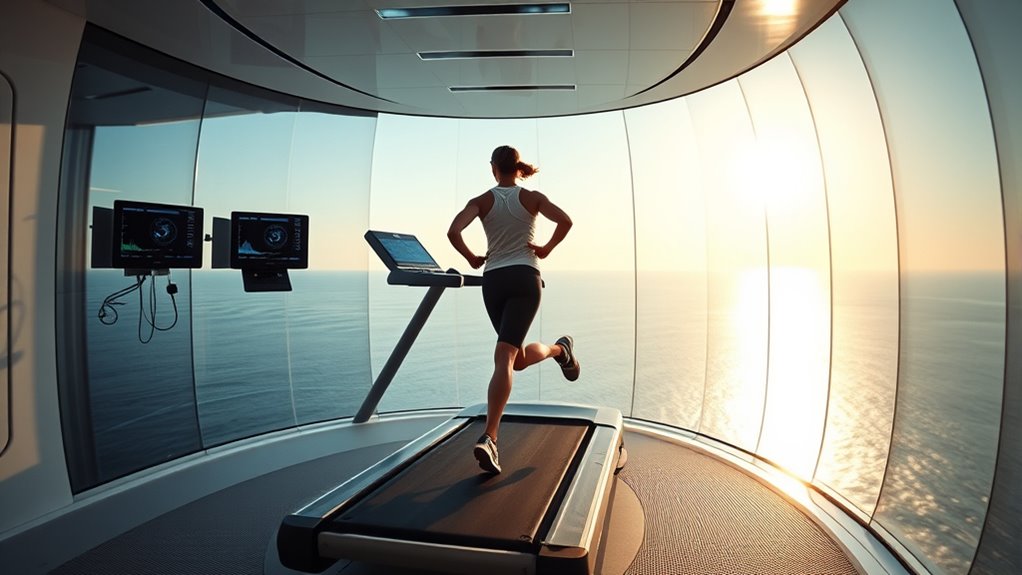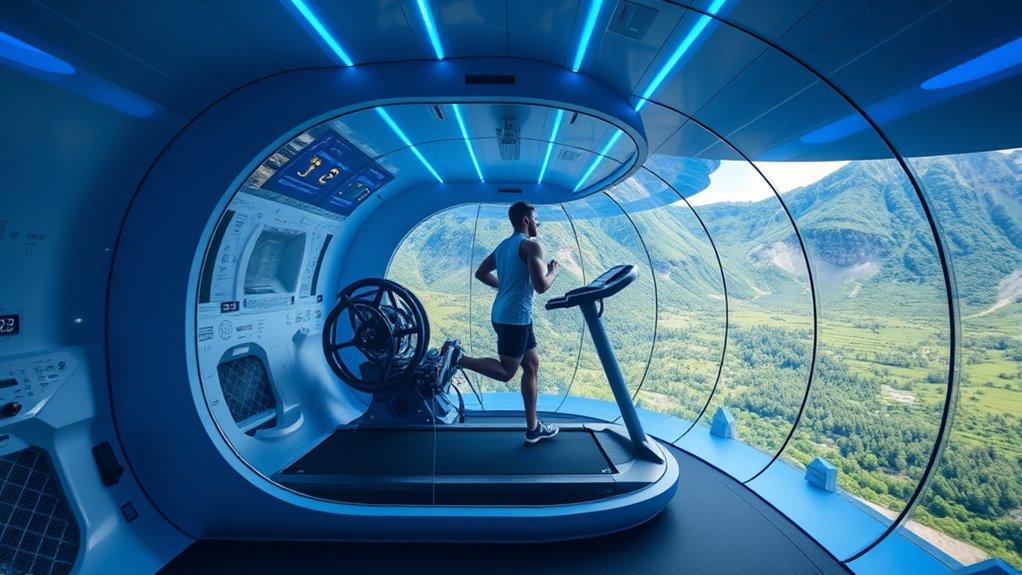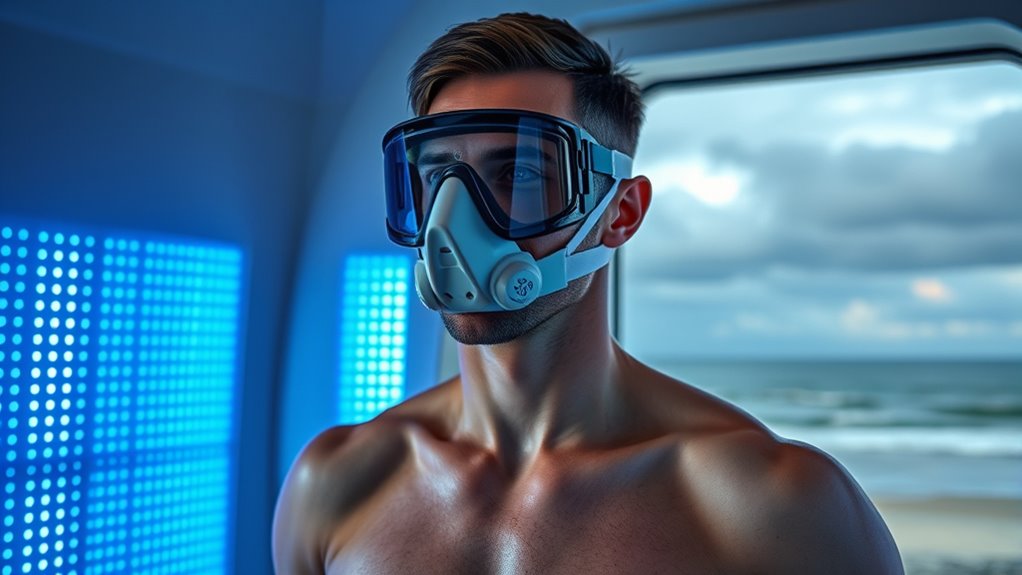Yes, altitude training at sea level is possible thanks to advanced simulation devices like hypoxic chambers, tents, and masks that mimic high-altitude conditions. These tools control oxygen levels, stimulating your body to produce more red blood cells and improve oxygen efficiency without traveling or risking altitude sickness. This way, you get the benefits of altitude training safely and conveniently. If you keep exploring, you’ll discover how technology is making this even more effective and accessible.
Key Takeaways
- Yes, altitude training at sea level is possible using simulated environments like hypoxic chambers and tents.
- These devices replicate low-oxygen conditions to induce physiological adaptations similar to high-altitude training.
- Proper protocols and consistent use maximize benefits such as increased red blood cell production and oxygen efficiency.
- Simulated altitude training reduces risks associated with actual high-altitude exposure, like altitude sickness.
- Advances in technology enable safe, convenient, and personalized altitude training at sea level.
The Science Behind Altitude Training Benefits

Understanding how altitude training works begins with recognizing its impact on your body. When you’re exposed to higher elevations, your body responds by increasing oxygen efficiency. This means your lungs and blood work together more effectively to absorb and deliver oxygen to your muscles. A key change involves hematocrit levels—the proportion of red blood cells in your blood. Elevated hematocrit allows more oxygen to be transported, enhancing endurance and recovery. These adaptations occur because your body perceives a lower oxygen environment and compensates by producing more red blood cells. Additionally, oxygen efficiency improves as your body adapts, making your training more effective. The process also stimulates erythropoietin production, which encourages red blood cell synthesis, further improving oxygen transport. As a result, even when you return to sea level, your improved oxygen transport helps you perform better. This biological response is the core reason behind many altitude training benefits, boosting your athletic capacity over time. Moreover, the body’s ability to adapt to hypoxia is crucial for maximizing these effects and can be stimulated through simulated altitude training methods. These physiological changes demonstrate how your body can respond to lower oxygen levels even under controlled conditions.
Techniques for Simulating High-Altitude Conditions at Sea Level

To simulate high-altitude conditions at sea level, athletes and trainers use a variety of techniques that replicate the oxygen-limited environment found at elevation. These methods induce oxygen deprivation without actual altitude exposure, helping your body adapt. Common techniques include:
- Hypoxic chambers—sealed rooms with reduced oxygen levels that mimic altitude conditions. These chambers can be precisely controlled to simulate different elevations, providing a consistent training environment.
- Hypoxic tents—personalized tents that lower oxygen intake during sleep or training. This method allows for targeted exposure during rest periods, promoting adaptation over time.
- Masks with controlled airflow—devices that restrict oxygen during workouts to simulate altitude sickness. These masks are portable and can be used during various types of exercise to challenge the respiratory system.
- Altitude training simulators—advanced systems that generate low-oxygen environments for short-term use. They often incorporate realistic environmental controls to enhance training effectiveness.
- Some Kia Tuning modifications, such as ECU remapping and performance upgrades, can be likened to tuning the body’s response to stressors like low oxygen levels, enhancing overall endurance and resilience. Additionally, Hyundai Tuning techniques, such as engine remapping and suspension upgrades, share similarities in optimizing performance under stress conditions. The use of performance monitoring devices can help athletes track their physiological responses during simulated altitude training.
- Incorporating mental conditioning techniques can further improve adaptation by helping athletes maintain focus and manage discomfort during hypoxic sessions. These approaches allow you to experience some effects of altitude training without traveling, but it’s essential to monitor for symptoms like altitude sickness and avoid overexposure.
Effectiveness of Hypoxic Chambers and Masks

Hypoxic chambers and masks have gained popularity as practical tools for altitude training, but their effectiveness varies depending on how they’re used. If you incorporate breathing exercises, these devices can help simulate low-oxygen environments, promoting adaptations similar to high-altitude exposure. However, the benefits depend on consistent use and proper protocols. Oxygen supplementation through these devices can increase oxygen levels temporarily, but it may not produce the same long-term adaptations as actual altitude training. Some users experience improvements in stamina and recovery, but evidence remains mixed. To maximize effectiveness, combine hypoxic training with other methods and ensure you follow structured routines. Additionally, understanding the principles of the Law of Attraction can help maintain a positive mindset and motivation during your training journey. Ultimately, while hypoxic chambers and masks offer convenience, their ability to fully replicate true altitude training remains limited without complementary strategies.
Comparing Traditional and Simulated Altitude Training Outcomes

Traditional altitude training involves physically ascending to high elevations, exposing your body to reduced oxygen levels directly in the environment. When mountain climbing, you might experience altitude sickness, which can hinder progress. Comparing this to simulated altitude training, you benefit from safety and convenience but may not fully replicate the physiological stress. Consider these points:
- Traditional training often results in faster altitude acclimatization due to real environmental exposure.
- Simulated methods provide controlled conditions, reducing risks like altitude sickness.
- Outcomes like increased red blood cell production are similar, but traditional methods may produce more rapid adaptations.
- You can achieve comparable results at sea level using simulated altitude, avoiding the physical toll of mountain climbing and altitude sickness.
Future Directions and Emerging Technologies in Altitude Training

Advances in technology are paving the way for more effective and accessible altitude training methods. Emerging tools like gene editing and personalized genetic profiling could enhance understanding of genetic adaptation, helping athletes optimize training protocols based on their unique biology. Virtual reality and neurofeedback technologies are also advancing mental resilience, enabling athletes to improve focus and reduce altitude-related stress. Wearable devices now monitor physiological responses in real time, allowing precise adjustments during training. These innovations aim to mimic high-altitude effects without requiring actual elevation, making altitude training more practical at sea level. As research progresses, integrating genetic insights and mental resilience strategies will likely revolutionize altitude training, boosting performance while reducing risks. Additionally, developments in training simulation technology are enabling athletes to experience altitude-like conditions in controlled environments. The future holds promising possibilities for customized, tech-driven altitude training solutions, including the use of altitude simulation chambers and virtual environments to replicate high-altitude effects with increased safety and convenience. Furthermore, advancements in data privacy ensure that athletes’ sensitive health data are protected as these new technologies become more widely adopted. Moreover, integrating mindfulness techniques into training regimens could further enhance mental focus and resilience during altitude simulation training.
Frequently Asked Questions
Can Altitude Training Improve Athletic Performance Without Physical Exertion?
You might wonder if altitude training can boost performance without exertion. While physical activity is key, hypoxia exposure or oxygen therapy can simulate high-altitude effects, potentially enhancing your endurance over time. These methods increase your body’s efficiency in utilizing oxygen, but they don’t replace the benefits of actual training. So, for performance gains, combining hypoxia exposure or oxygen therapy with physical exercise remains the most effective approach.
Are There Any Health Risks Associated With Simulated Altitude Training at Sea Level?
Imagine a steam engine struggling with oxygen deprivation—similarly, simulated altitude can stress your body. You should know there are health risks, such as potential cardiovascular impact and oxygen deprivation, which might cause dizziness, headaches, or even more serious issues. While beneficial for some, it’s vital to consult a healthcare professional before starting, as improper use could pose significant risks, especially if you have underlying health conditions.
How Long Does It Take to See Benefits From Altitude Training?
You might start noticing timing benefits from altitude training in about 2 to 4 weeks, as your body begins to adapt through training adaptation. Consistent sessions help improve your red blood cell production, boosting oxygen delivery. While some athletes see early results, ideal benefits often develop over several months. Remember, individual responses vary, and combining altitude training with proper rest and nutrition accelerates the timing benefits you seek.
Is Altitude Training Effective for Non-Athletes or Recreational Exercisers?
Altitude training isn’t just for elite athletes; it can be a game-changer for you too! Even as a recreational exerciser or senior, you’ll find potential benefits like improved stamina, better weight management, and enhanced overall health. While it may not turn you into a marathon runner overnight, regular altitude-inspired workouts can boost your fitness and support healthy aging. Give it a try—you might be surprised by how much you can achieve!
Can Altitude Simulation Devices Be Customized for Individual Health Conditions?
You can have altitude simulation devices customized for your health condition, allowing for personalized protocols that suit your specific needs. Manufacturers often offer adjustments based on health conditions, ensuring safe and effective training or therapy. By working with professionals, you get tailored altitude levels and durations, helping you optimize benefits while minimizing risks. These personalized adjustments make altitude simulation more accessible and safer for individuals with diverse health backgrounds.
Conclusion
By exploring new methods like hypoxic chambers and masks, you can potentially experience altitude training benefits right at sea level. For example, imagine an athlete using a hypoxic chamber who notices improved endurance and recovery. While it’s not identical to true high-altitude training, these techniques could help you access better performance without leaving your home. Keep an eye on emerging technologies—they might just revolutionize how you train and achieve your goals.









